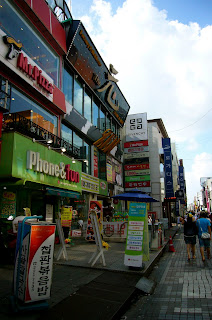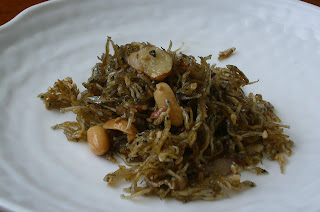Seoraksan National Park
My destination this past weekend was Seoraksan National Park, the largest of the Korean National Parks. Although it doesn't include the highest peak in Korea, the Seorak range is acclaimed for its series of dramatic rocky peaks and flora and fauna. Many rare animals and plants are found in the park, especially in the lesser visited areas. UNESCO designed the park a Biosphere Reserve in 1992. The park literature identifies three sections of Seorak and the highest peak is nestled in the middle of Inner Seorak. My target was Outer Seorak, the most accessible and popular part of the park.

Although there were a number of a serious hikers out, recognizable in their uniform of performance tops, black pants, real hiking boots and hiking poles, plenty of women opted for heels or backless sandals and cute tops. One might suppose that they were not there to hike, and just had plans to enjoy the fresh air and refreshments, but I did see some hobbling down trails. Seorak is one of the most beloved mountain areas in Korea and is consequently quite busy. Many school groups take trips here and actually several of my middle school students visited Seoraksan just a few weeks ago with their schools. I was visiting over a three day holiday weekend, so luckily I didn't encounter any boisterous school groups, but I did feel surrounded by people pretty much the whole time.
Without a plan, I decided to explore the temple area first and then figure out what to do. The temple lay just beyond this statue of a large seated Buddha.


From the well-kept temple, there were picturesque views of the nearby peaks, leading one to hope that the residing monks are satisfied with their location.


Since I have found the hiking trails in Korea to be generally quite steep, I was excited for one feature of the park in particular: a cable car. A quick ride on the Kwongeumseong cable car brought me to an elevation of 2198 feet. After a short 10 minute walk, I was on the top of Biseondae, Flying Fairy Peak, and had beautiful views of the surrounding peaks. Each cable car could hold 50 people (but I don't think they filled the cars to capacity each time) and the cars ran every 5 minutes. The cable car cost $8 for return for adults and $5 for children; so in addition to the $2.50 park entrance fee, the park is taking in quite a bit of money!


In a lot of my pictures, I may give the illusion that no other people are around. I don't like random people in my pictures, especially if I'm not trying to take a people picture. However, as you can see, there are always lots of Koreans around.
I thought I could access the waterfall trail from trails near the cable car, but I was mistaken. I took the cable car back down to the bottom of the park and connected with the waterfalls trail. After an easy couple of kilometers, I found myself face to face not only with this waterfall but also with a couple that I know from Cheongju! Considering I know so few people in Korea, I thought it was a lucky coincidence to run into people I know.

I was feeling unusually lonely and out of sorts since departing from Cheongju, so I was happy to some company for awhile. We enjoyed a snack in the shade before moving on to a spot by the river (this is quite a generous term for the meager flow between all the rocks on the river bed). We all wondered whether the woman in the boldly printed "Fuckin' t-shirt store" t-shirt knew what she was wearing. (I was perhaps even more curious about the woman in Seoul who had a bag with thankfully smallish lettering repeating "We are baby poo".)
Jena and Alan had tickets for the cable car, so we parted ways. I found myself a quiet place along the river bed and enjoyed the cool water and the impressive views.

In terms of natural beauty, Seoraksan is probably the most impressive place I've seen in Korea. I didn't do much hiking, but I more importantly had a relaxing and pleasant day outside.



















































